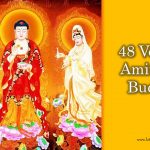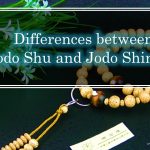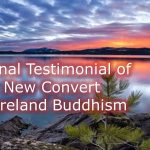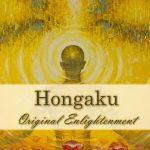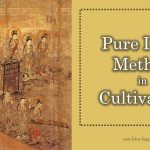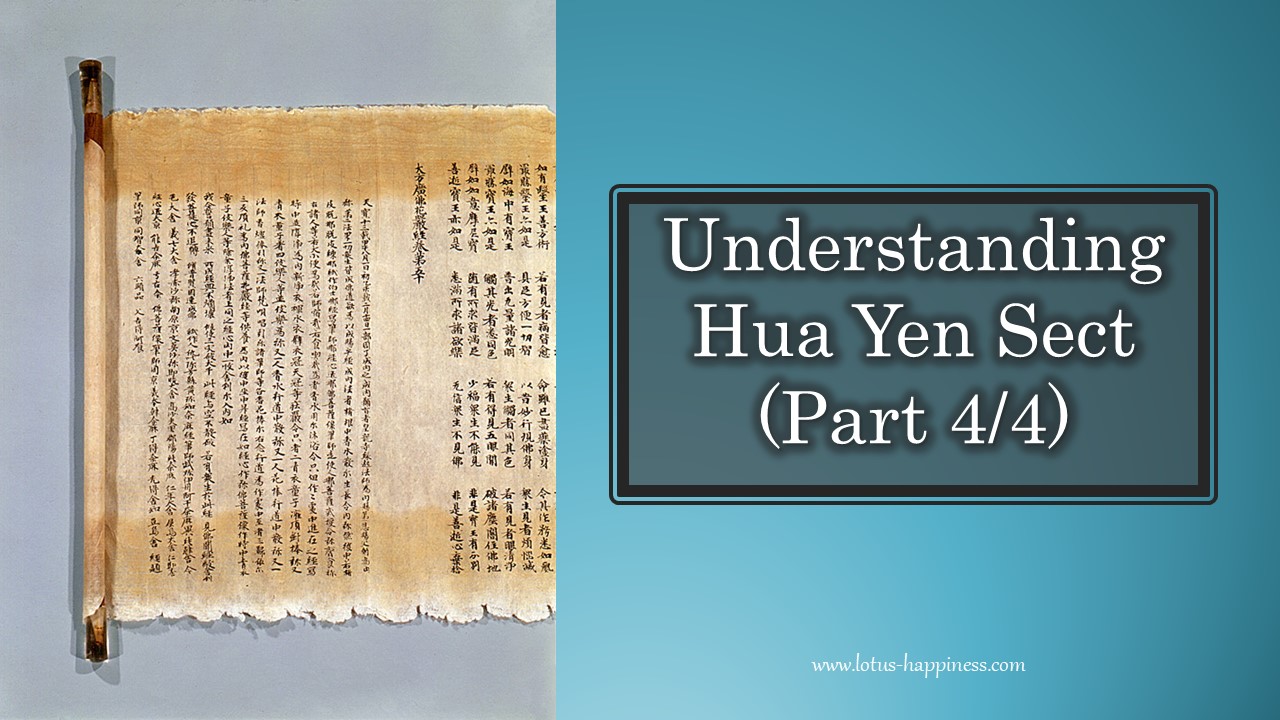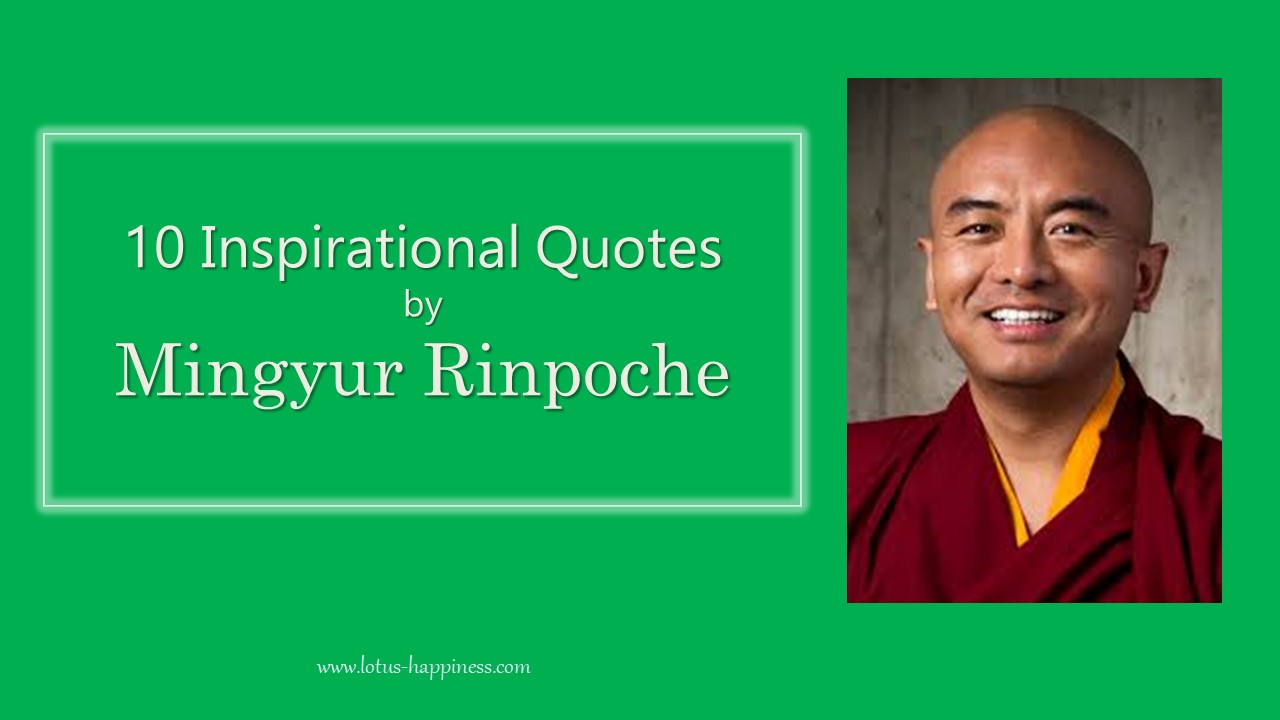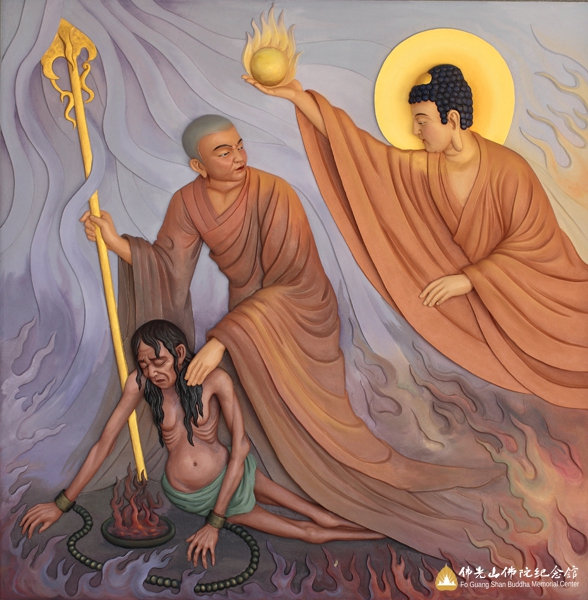Tendai Buddhism and the Practice of Amitabha Buddha
By Tendai UK
AMIDA BUTSU 阿弥陀仏 (AMITABHA BUDDHA)
Originally, Amida was a Bodhisattva monk called Dharmakāra (Hōzō 法蔵). He was a king who, like Shakyamuni, gave up his thrown to become a monk. After eons of practice, he became Dharmakāra Bodhisattva, who then made 48 vows. Having fulfilled them, he became known as Amitābha Buddha. This story doesn’t have any historicity to it. There is no record that such a person existed, however, like the story of Shakyamuni with its embellishments, it’s meant to inspire rather than take seriously.
Amida has two Sanskrit names; Amitābha – meaning Infinite light. And Amitāyus – meaning Infinite life. People often assume that ‘infinite’ is against Buddhist teachings, but this comes from the lack of a decent translation for ‘amita’, which can mean “without limit” or “without bounds”. ‘Abha’ can also mean ‘splendor’. His name, then, can be better translated as ‘His splender has no bounds’ meaning, there is no place that his ‘splendor/light’ can’t reach. The same is true for his other name Amitāyus – Infinite life. So now, instead of an immortal figure, we get the impression of an extremely compassionate person who will go to any length (no bounds) to help people.
The practice most synonymous with Amida, is that of nembutsu 念仏 (Namo Amida Butsu) in which one intones his mantra/refuge in order to reborn in the Pure Land after life. The question on most peoples’ lips is “is this a literal belief or rhetoric?” Looking at it from a Tendai perspective, I have seen evidence for both interpretations existing simultaneously. Chih-i’s Amida practice (Jōgyō zanmai), in which one keeps in mind the image of Amida Buddha (Butsuryū – Buddha imaging) whilst chanting the nembutsu and constantly walking for 90 days, was not seen as a means to attain rebirth in the Pure Land. Instead, it was a way of realising the Pure Land in the mind. This is not to say that Chih-i didn’t believe in the Pure Land, as on his death bed the Pure Land texts were read and, as he was dying, he said he could see Kannon coming to escort him to the Pure Land. – [Sand and Pebbles: The Tales of Muju Ichien, A Voice for Pluralism in Kamakura Buddhism, by Mujū Ichien, Robert E. Morrell.]
Trikaya (Three Bodies)
Chih-i understood Amida to be a Sambhogakaya. In order to understand this, much more explanation needs to be made about the Trikaya (三身 Sanjin, three bodies), however, put briefly;
The Trikaya are aspects of the Buddha, distinct and yet unified.
Nirmanakāya (ōjin 応身) is the manifested body (physical body), that we can see and interact with i.e. seen by anyone. In this sense – Shakyamuni is a (supreme) Nirmanakaya. This is a provisional appearance.
Sambhogakāya (hōjin 報身) is the bliss body (aka reward body) which can only be known by those with the right karmic conditions. It can also be known as “subtle body of limitless form” and both celestial Buddhas (such as Bhaisajyaguru) and high level Bodhisattvas (such as Avalokiteshvara) can appear as Sambhogakaya. These Buddhas and Bodhisattvas manifest themselves in their corresponding Pure Lands. This is also a provisional appearance.
Dharmakāya (hosshin 法身) is the body of reality itself (truth body), without limit or limited to form (unmanifested) and inconceivable to those unenlightened (manifestations of Dharmakaya are known as Nirmanakaya). It is the Absolute – nature as it is and is synonymous with shunyata (emptiness). Mahāvairocana is a Dharmakāya.
The name of Amida can also be understood in terms of the Three Truths. In Japanese (and Chinese, I believe) Amida is also be known as 無量寿仏 Muryoju-butsu, meaning “Infinite Life Buddha”. The characters of both these names relate back to the Three Truths; 無 Mu is equivalent to 阿 A and relates to the Truth of Emptiness (kū). 量 Ryo is equivalent to 弥 Mi and relates to the Truth of the Conditioned (ke). 寿 Ju is equivalent to 陀 Da and relates to the Truth of the Middle (chū). Therefore, meditation on the Nembutsu can also be a meditation on the Three Truths, and to realise the Three Truths is to realise Amida. I also find a correlation between the three truths and the three bodies (trikaya). Many people ask “Is Amida real?”, but when we understand the Three Truths and the Three Bodies, the answer tends to be “define real!”
Anyway, this dual aspect of understanding the practice of Amida, for both realising the Pure Land in the mind AND to attain rebirth in the Pure Land after death, continues in the disciples of Chih-i and then continues through to Japan.
Chih-I Teaches Three Methods of Nembutsu in Maka Shikan
Chih-i, in his Moho Chihkuan (Maka Shikan) text distinguishes 3 different methods of nembutsu; the first is to contemplate the Major and Minor Marks/Qualities of a Buddha. The second is to contemplate the Buddhas abstract qualities, such as the Buddha’s Four Unique Qualities. The third (and final stage) is to contemplate the Buddha’s essential nature/the true characteristic of all phenomena. “So where does chanting “Namu Amida Butsu” come in?”, I hear you ask! Chih-i states, that whilst one practices these contemplations, one should continuously intone “Namu Amida Butsu”, so that ones mind is wholly directed toward Amitabha Buddha. This is the practice of Jogyo Zanmai (Constantly walking Samadhi) which Chih-i based on the Pratyutpanna Samadhi Sutra. On “Namu Amida Butsu”, Chih-i states, “Invoking Amitabha’s [name] is equivalent to invoking [the names of] all the Buddhas…. so in this case we simply focus on Amitabha as the essential gate of access to Dharma.” (Traditions of Meditation in Chinese Buddhism)
Ennin (Jikaku Daishi)
It’s difficult to say what Saicho’s thoughts were on the Nembutsu and Amida as there aren’t many works in English, however his disciple, Ennin (Jikaku Daishi) continued the practice of Jōgyō zanmai, even constructing the Jōgyōdo常行堂 on Mt Hiei. Ennin also brought back the Inzei Nembutsu 引聲念佛, that is, repetition of the Nembutsu with a tone (early form of shomyo). This practice of singing the nembutsu continued to grow and develop, even influencing Japanese music to this very day. The Pure Land sects have their own version of these singing nembutsus. However, it should be stressed that, like his predecessors, it seems Ennin did not propagate this practice in order to be reborn in the Pure Land. At the time, the practices for gaining rebirth in the Pure Land were death bed practices, that is, either you or your attendants would chant Pure Land texts and the nembutsu as you lay dying.
I think this view began to shift with Ryōgen 良源 (Jie Daishi) and his disciples Genshin 源信 and Kakuun 覚運. During the time of Ryōgen, Japan was in a time of strife. There were many waring lords and waring temples all looking for dominance. Ryōgen even hired the now infamous (and so-called) Sohei 僧兵warrior monks for protection, as there were even factions developing on Mt Hiei.
Going back to Genshin and Kakuun – many monks in their time saw this strife and bloodshed as an indication that we were heading into Mappo末法 – the dharma ending age. According to tradition, during this time it would be difficult, close to impossible, for people to attain enlightenment by their own efforts (jiriki 自力– self power). Sentient beings needed help (tariki 他力 – other power). For Genshin and Kakuun, thanks to the influence of their teacher Ryōgen, Amida filled this need.
Kakuun
Kakuun is now not well known, but is the founder of the Danna school of Tendai. His approach to Amida was more esoteric – that is, Amida was to be realised through practice and effort (shikaku 始覚– acquired enlightenment). For Genshin, and his now famous Ōjōyōshū (往生要集 Essentials for rebirth in the Pure Land), faith in Amida and chanting the nembutsu was enough for rebirth in the Pure Land and enlightenment. This is not to say he disregarded practice. On the contrary, the practice was complementary to faith. But Genshin’s Eshin line of the Tendai school emphasised inherent enlightenment (aka original enlightenment – hongaku 本覚), the idea that we are already enlightened, it just needs to be realised through practice. So we can see, both the literal rebirth understanding and the mind-only understanding of Amida and nembutsu is still present in Tendai, but the emphasis has started to shift towards rebirth in the Pure Land. This shift continues into the Kamakura period (鎌倉時代 Kamakura jidai, 1185–1333). As we move into the Kamakura period, the turmoil that has been affecting Japan and the various Buddhist schools have really begun to take its toll. For those living it, it really was the age of mappo. This is the period when the so-called “single practice” schools emerge, such as Zen (Soto and Rinzai), Pure Land (Jodo Shu) and Nichiren. Each school having its own focus on a particular practice, rather than the eclectic approach of Tendai. Interestingly, each of the founders were Tendai monks themselves.
As these schools arose, the Tendai Shu had its own answer to the single practice. Instead of the Nembutsu, its answer to the single practice was the Shinnyokan 真如観. Shinnyokan is a meditation on “Suchness”, synonymous with the “middle truth”, of truth just as it is – of reality – stemming from the idea that we are already enlightened and we just need to realise it (hongaku). This meditation, whilst not something new, was given new attention and became a practice for lay people.
This is not to say that the nembutsu was ignored. The practice continued to be developed, taking influence from the nembutsu schools (there were many that sprang up) as well as Shingon with its own esoteric understanding of Amida in which Amida is synonymous with Dainichi Nyorai and the Dharmakaya. As far as I’m aware, the Tendai Shu still sees Amida as Sambhogakāya, but there may be lineages that take a different view.
Esoteric Tendai
In esoteric Tendai (taimitsu), Amida is one of the 5 Dhyani Buddas 五方佛 also known as the 5 Wisdom Tathagatas 五智如来. In the Kongōkai Mandala he is shown as Amitābha (Infinite light), taking a seat on the west side of Dainichi Nyorai. In the Taizōkai Mandala he is shown as Muryōju (Infinite life), again sat to the west of Dainichi Nyorai. In taimitsu he is a member of the Lotus Family, with the element of water, the colour red and has the Bija Hrih (Kiriku in Japanese). Our head temple in Japan, Senzoji, has the practice of Gojusoden, in which one progresses through a series of mantras and meditations on Amida and his qualities.
Looking through all of this, I feel it’s clear that, in Tendai at least, that the practice and fruit of the practice of Amida, is both for the benefit of our minds right here and now, as well as for the future (or future lives). In the spirit of ichinen sanzen (一念三千 – three thousand worlds in a single thought), when we chant the nembutsu and meditate on Amida we are connecting our minds with Amida’s qualities. We become unified with Amida, as Amida is unified with us, awaking our own Buddhanature. So the nembutsu is not just a practice for rebirth, but it’s a practice for enlightenment.
Of course, these are all my own thoughts and there may be many mistakes. If you’d like to correct anything or add anything please do. Namo Amida Butsu.
Note: The Gokuraku Jodo Kuhon Ojogi 極楽浄土九品往生義 (Nine grade of Rebirth in the Pure Land of Amitabha) by Ryogen currently does not have an English translation.
Source: Tendai UK


